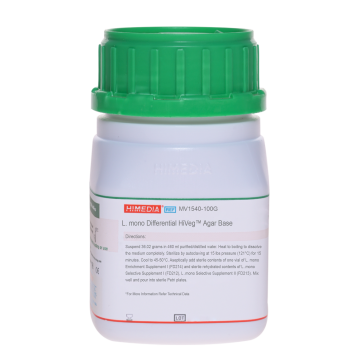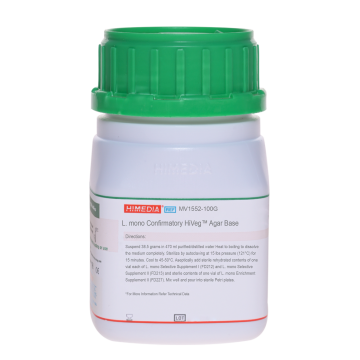 Your enquiry has been submitted
Your enquiry has been submitted
L. mono Confirmatory Agar Base
Intended Use
Recommended for the selective and differential isolation of Listeria monocytogenes from clinical and food specimens.
Composition**
| Ingredients | g / L |
|---|---|
| Special peptone | 30.000 |
| Yeast extract | 6.000 |
| Sodium chloride | 5.000 |
| Lithium chloride | 10.000 |
| Disodium hydrogen phosphate | 2.500 |
| B.C. indicator | 8.600 |
| α-Methyl D-mannoside | 3.000 |
| Agar | 12.000 |
Final pH (at 25°C): 7.2±0.2
**Formula adjusted, standardized to suit performance parameters
Directions
Suspend 38.5 grams in 470 ml purified/distilled water. Heat to boiling to dissolve the medium completely. Sterilize by autoclaving at 15 lbs pressure (121°C) for 15 minutes. Cool to 45-50°C. Aseptically add sterile rehydrated contents of one vial of OA Selective Supplement (FD212A) and sterile contents of one vial of **LM Enrichment Supplement II (FD227). Mix well and pour into sterile Petri plates.
Principle And Interpretation
Listeria monocytogenes is a gram-positive foodborne human pathogen responsible for serious infections in pregnant women that may ultimately result in abortion, stillbirth, birth of a child with neonatal listeriosis and meningitis or primary bacteremia in adults and juveniles. The pathogenicity of Listeria ivanovii for humans is uncertain. Since L. monocytogenes and L. innocua have similar biochemical properties, they cannot be differentiated on traditional media (PALCAM, Oxford). L. mono Confirmatory Agar Base is a modification of the formulation of Ottoviani and Agosti (1,2) for the selective and differential isolation of Listeria monocytogenes.
Special peptone and yeast extract serve as nitrogen sources and provide essential nutrients required for the growth of Listeria. α-Methyl-D-mannoside is the fermentable carbohydrate. Lithium chloride and added selective supplements (FD212 and FD213) inhibit accompanying microflora and thus enhance the selectivity of the medium for Listeria species. Sodium chloride maintains the osmotic equilibrium and disodium hydrogen phosphate buffers the medium. Differentiation of L. monocytogenes from other Listeria species is based on phosphatidylinositol-specific phospholipase C (PIPLC) activity and fermentation of α-Methyl D-mannoside. Phospholipase C enzyme is an important virulence factor and is specific to only L. monocytogenes and L. ivanovii. Phospholipase C enzyme produced by L. monocytogenes and L. ivanovii hydrolyses the purified substrate (FD227) added to the medium and results in the formation of an opaque halo around the colonies.
Differentiation between L. monocytogenes and L. ivanovii is achieved on the basis of alpha-Methyl D-mannoside utilization and PIPLC activity. L. monocytogenes ferments alpha-Methyl D-mannoside forming yellow coloured colonies with halo whereas L. ivanovii fails to ferment alpha-Methyl D-mannoside and therefore forms purple coloured colonies with halo. Other Listeria species do not exhibit PIPLC activity and therefore they form either purple or yellow coloured colonies without halo.
Type of specimen
Clinical samples and Food samples.
Specimen Collection and Handling
For food samples, follow appropriate techniques for sample collection and processing as per guidelines (3). For clinical samples follow appropriate techniques for handling specimens as per established guidelines (4,5). After use, contaminated materials must be sterilized by autoclaving before discarding.
Warning and Precautions
In Vitro diagnostic Use. For professional use only. Read the label before opening the container. Wear protective gloves/protective clothing/eye protection/face protection. Follow good microbiological lab practices while handling specimens and culture. Standard precautions as per established guidelines should be followed while handling clinical specimens. Safety guidelines may be referred in individual safety data sheets.
Limitations
- Other Listeria species do not exhibit PIPLC activity and therefore they form either purple or yellow coloured colonies without halo.
Performance and Evaluation
Performance of the medium is expected when used as per the direction on the label within the expiry period when stored at recommended temperature.
Quality Control
Appearance: Beige to purple homogeneous free flowing powder
Gelling: Firm, comparable with 1.2% Agar gel.
Colour and Clarity of prepared medium: Purple coloured, opalescent gel forms in Petri plates
Reaction: Reaction of 7.7% w/v aqueous solution at 25°C. pH : 7.2±0.2
pH: 7.00-7.40
Cultural Response: Cultural characteristics observed with added supplements, OA Selective Supplement (FD212A) and **LM Enrichment Supplement II (FD227), after an incubation at 35-37°C for 24-48 hours.
| Organism | Inoculum (CFU) | Growth | Recovery | Colour of Colony | PIPLC activity |
|---|---|---|---|---|---|
| Candida albicans ATCC 10231 (00054*) | >=10^4 | inhibited | 0 % | ||
| Enterococcus faecalis ATCC 29212 (00087*) | >=10^4 | inhibited | 0 % | ||
| Escherichia coli ATCC 25922 (00013*) | >=10^4 | inhibited | 0 % | ||
| Listeria innocua ATCC 33090 (00017*) | 50-100 | luxuriant | >=50% | yellow | negative |
| Listeria grayi ATCC 19120 | 50-100 | luxuriant | >=50% | yellow | negative |
| Listeria ivanovii ATCC 19119 | 50-100 | luxuriant | >=50% | light purple | positive, opaque halo around the colony exhibiting phosphatidylinositol specific phospholipase activity |
| Listeria monocytogenes ATCC 19112 | 50-100 | luxuriant | >=50% | yellow | positive, opaque halo around the colony exhibiting phosphatidylinositol specific phospholipase activity |
| Listeria seeligeri ATCC 35967 | 50-100 | luxuriant | >=50% | light purple | negative |
| Listeria welshimeri ATCC 43549 | 50-100 | luxuriant | >=50% | yellow | negative |
| Pseudomonas aeruginosa ATCC 27853 (00025*) | >=10^4 | inhibited | 0% |
Key : (*) Corresponding WDCM numbers.
Storage and Shelf Life
Store between 10-30°C in a tightly closed container and the prepared medium at 2-8°C. Use before expiry date on the label. On opening, product should be properly stored dry, after tightly capping the bottle in order to prevent lump formation due to the hygroscopic nature of the product. Improper storage of the product may lead to lump formation. Store in dry ventilated area protected from extremes of temperature and sources of ignition. Seal the container tightly after use. Product performance is best if used within stated expiry period.
Disposal
User must ensure safe disposal by autoclaving and/or incineration of used or unusable preparations of this product. Follow established laboratory procedures in disposing of infectious materials and material that comes into contact with clinical sample must be decontaminated and disposed of in accordance with current laboratory techniques (4,5).
Reference
- Ottaviani F., Ottaviani M., and Agosti M. (1997 a), Industrie Alimentari 36, 1-3.
- Ottaviani F., Ottaviani M., and Agosti M. (1997 b), Quimper Froid Symposium Proceedings p.6, A.D.R.I.A. Quimper, France, 16-18 June 1997.
- Salfinger Y., and Tortorello M.L. Fifth (Ed.), 2015, Compendium of Methods for the Microbiological Examination of Foods, 5th Ed., American Public Health Association, Washington, D.C.
- Isenberg, H.D. Clinical Microbiology Procedures Handbook 2nd Edition.
- Jorgensen, J.H., Pfaller, M.A., Carroll, K.C., Funke, G., Landry, M.L., Richter, S.S and Warnock., D.W. (2015) Manual of Clinical Microbiology, 11th Edition. Vol. 1.
| Product Name | L. mono Confirmatory Agar Base |
|---|---|
| SKU | M1552 |
| Product Type | Regular |
| Physical Form | Powder |
| Origin | Animal |
| Packaging type | HDPE |
| References | 1.Ottaviani F., Ottaviani M., and Agosti M. (1997 a), Industrie Alimentari 36, 1-3.2.Ottaviani F., Ottaviani M., and Agosti M. (1997 b), Quimper Froid Symposium Proceedings p.6, A.D.R.I.A. Quimper, France,16-18 June 1997. |
| Customized Product Available | No |









